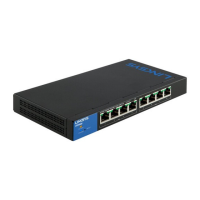55
Table of Contents
Linksys
Chapter 9 Multicast
Multicast
This section describes the Multicast Forwarding feature and covers the
following topics:
• Overview
• Feature Configuration
• IGMP/MLD Snooping
• Multicast Router Ports
• Forward All
• Unregistered Multicast
• IGMP/MLD IP Group Addresses
• MAC Group Address FDB
• IP Group Address FDB
Overview
Multicast forwarding enables one-to-many information dissemination.
Multicast applications are useful for dissemination of information to multiple
clients, where clients do not require reception of the entire content. A typical
application is a cable-TV-like service, where clients can join a channel in the
middle of a transmission, and leave before it ends.
The data is sent only to relevant ports. Forwarding the data only to the relevant
ports conserves bandwidth and host resources on links.
For Multicast forwarding to work across IP subnets, nodes and routers must be
Multicast-capable. A Multicast-capable node must be able to do the following:
• Send and receive Multicast packets.
• Register the Multicast addresses being listened to by the node with
local routers, so that local and remote routers can route the Multicast
packet to the nodes.
Typical Multicast Setup
• While Multicast routers route Multicast packets between IP subnets,
Multicastcapable Layer 2 switches forward Multicast packets to registered
nodes within a LAN or VLAN.
A typical setup involves a router that forwards the Multicast streams between
private and/or public IP networks, a device with Internet Group Membership
Protocol (IGMP) snooping capabilities, and a Multicast client that wants
to receive a Multicast stream. In this setup, the router sends IGMP queries
periodically.
These queries reach the device, which in turn floods the queries to the VLAN,
and also learns the port where there is a Multicast router (Mrouter). When a
host receives the IGMP query message, it responds with an IGMP Join message
saying that the host wants to receive a specific Multicast stream and optionally
from a specific source. The device with IGMP snooping analyzes the Join
messages, and learns that the Multicast stream the host has requested must be
forwarded to this specific port. It then forwards the IGMP Join to the Mrouter
only. Similarly, when the Mrouter receives an IGMP Join message, it learns the
interface from which it received the Join messages that wants to receive a
specific Multicast stream. The Mrouter forwards the requested Multicast stream
to the interface.
In a Layer 2 Multicast service, a Layer 2 switch receives a single frame addressed
to a specific Multicast address. It creates copies of the frame to be transmitted
on each relevant port.
When the device is IGMP snooping-enabled and receives a frame for a Multicast
stream, it forwards the Multicast frame to all the ports that have registered to
receive the Multicast stream using IGMP Join messages.
The device can forward Multicast streams based on one of the following options:
• Multicast MAC Group Address
• IP Multicast Group Address (G)
• A combination of the source IP address (S) and the destination IP
Multicast Group Address (G) of the Multicast packet.
• One of these options can be configured per VLAN.
The system maintains lists of Multicast groups for each VLAN, and this manages
the Multicast information that each port should receive. The Multicast groups
and their receiving ports can be configured statically or learned dynamically
using IGMP snooping.

